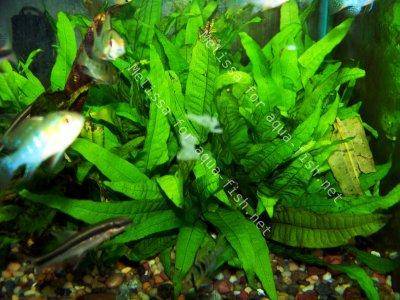Microsorium pteropus
Scientific name: Microsorium pteropus
Family: Polypodiaceae
Usual maximum size in aquariums: 20 - 25 cm (7.87 - 9.84 inch)
014
Recommended pH range for the species: 5.5 - 7.5
Recommended water hardness (dGH): 4 - 15°N (71.43 - 267.86ppm)
0°C 32°F30°C 86°F
Recommended temperature: 20 - 25 °C (68 - 77°F)
Reproduction of the plant: Runners
Origin (in the wild): South Asia
How fast these plants grow: Slow
Recommended substrate: Fine gravel
Demands on lighting: Medium
Ideal placement in a fish tank: Middle
Family
Polypodiaceae
Common Name
Java Fern
Planting Area
These are not planted in the substrate but are normally attached to the aquarium decor
Propagation
This plant will literally propagate itself. As the leaves mature, plantlets will appear on the edge of the leaves at the top. As the plantlets grow, they will detach themselves and float around the aquarium looking for some where to attach. Just before this is about to happen they can be pulled away carefully and attached to a piece of bogwood or rock with fishing line or a rubber band. In time they will attach themselves and the line or rubber band can be removed.
Difficulty
Easy
Short Description
This plant is very hardy and grows well in a wide range of water parameters. Fish tend not to nibble at these as not only are the leaves very tough but apparently they taste disgusting. This is one re4ason why they are a popular plant in aquariums that contain herbivorous fish.

